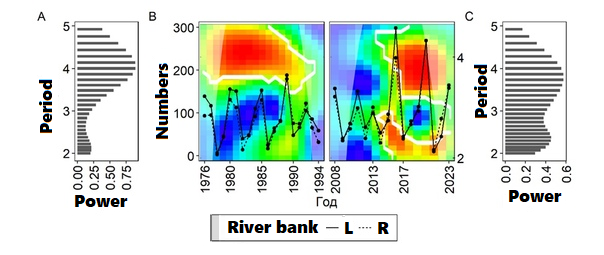
The study of population dynamics has been one of the classic problems in animal ecology since the time of Charles Elton. It is a widely known fact that at the end of the 20th and beginning of the 21st centuries, cyclical fluctuations in the numbers of several species were replaced by non-cyclical, or fluctuation ones. These processes are associated primarily with global climate change. However, in recent decades, isolated reports have been published in the literature that cyclical fluctuations are being restored.
Scientists from the A.N. Severtsov Institute of Ecology and Evolution of RAS analyzed time series containing data from long-term observations of a number of small mammals in the vicinity of the Mirnoye station of the Institute from 1976 to 1994 and from 2008 to 2023.
The following results were obtained from the analysis:
1) In the 20th century the dynamics of the population size of the community and a number of species included in its composition (common shrew - S. araneus, medium shrew - S. caecutiens, equal-toothed shrew - S. isodon, tundra shrew - S. tundrensis, small shrew - S. minutus, red-gray vole C. rufocanus, red-backed vole - C. rutilus, root vole - M. oeconomus, dark or arable vole - M. agrestis) were characterized by a four-year periodicity.
2) The peak in abundance was accompanied by a disturbance in the developmental stability of the model species S. araneus, expressed in an increase in skull asymmetry.
3) Periodic oscillations in the 20th century were primarily carried out by dominant and subdominant species; small-numbered species were characterized by low-amplitude oscillations without a clear periodicity.
4) Periodic fluctuations were synchronous on both banks of the Yenisei in populations of most species.
5) The phases of depression in different species tended to coincide, even if other stages of the cycle were different.
6) At the end of the 20th century, cyclical fluctuations in the number of the studied community and a number of species of small mammals included in its composition were replaced by fluctuating ones that do not have a clear periodicity.
7) In the case of fluctuations, desynchronization of oscillations was sometimes observed on different banks of the Yenisei.
8) In 2017-2020, a complete “classical” cycle of the community abundance and a number of dominant species included in its composition (S. araneus, S. isodon, C. rutilus, M. oeconomus) was observed, and the peak in abundance was accompanied by a violation of the stability of development model species S. araneus, which is similar to population cycles.
The results were published in the journal Integrative Zoology: Vasily D. Yakushov, Boris I. Sheftel (2024). Are population cycles recovering? Integrative Zoology. 19(3): 538-547. https://doi.org/10.1111/1749-4877.12770
Possible causes of disruption and restoration of cyclic oscillations will be discussed in the next publication.
